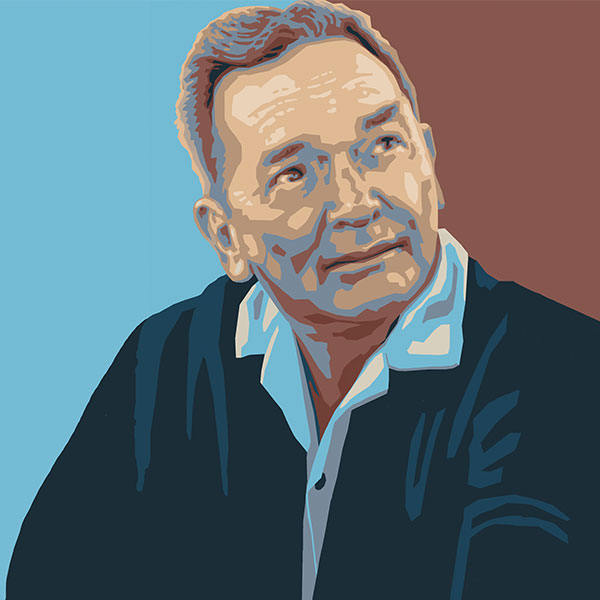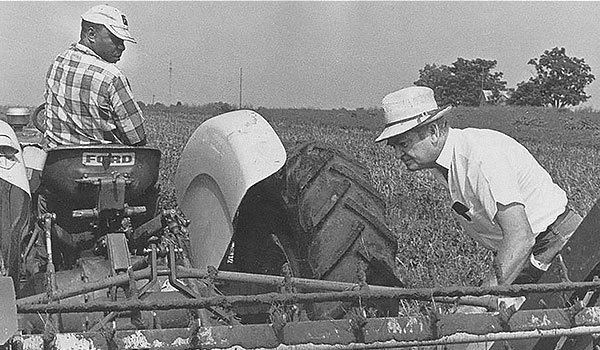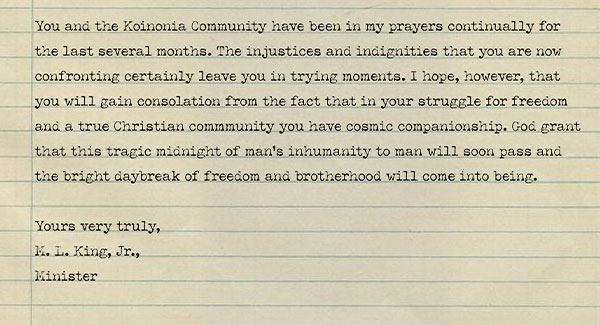Subtotal: $
Checkout-

Poem: “Blessing the Bells”
-

Poem: “Autumn in Chrysalis-Time”
-

Tiny Knights
-

Editors’ Picks: What Your Food Ate
-

Editors’ Picks: Untrustworthy
-

Editors’ Picks: The Last White Man
-

Retooling the Plough
-

Charting the Future of Pro-Life
-

Letters from Readers
-

Home in My Heart
-

Remembering Alice von Hildebrand
-

Sadhu Sundar Singh
-

Covering the Cover: The Vows That Bind
-

The Day No One Would Say the Nazis Were Bad
-

John Wayne, The Quiet Man
-

No Promises
-

Word Is Bond
-

Bring Back Hippocrates
-

The Dance of Devotion
-

Victor Hugo’s Masterpiece of Impossibility
-

A Vow Will Keep You
-

A Broken but Faithful Marriage
-

Can Love Take Sides?
-

A Defense of Vows
-

Why I Chose Poverty
-

Demystifying Chastity
-

The Adventure of Obedience
-

Vows of Baptism
-

Hutterite Ten Points of Baptism
-

The One Who Promises
-

Vows in Brief

The Raceless Gospel
Half a century after his death, Clarence Jordan still has much to teach America about war, wealth, race, and religion.
By Starlette Thomas
September 26, 2022
Clarence Jordan was a Southern Baptist pastor and farmer who, in 1942, founded Koinonia Farm, an interracial, pacifist communal experiment on depleted farmland in Americus, Georgia. The latest book in the Plough Spiritual Guides series, The Inconvenient Gospel: A Southern Prophet Tackles War, Wealth, Race, and Religion (October 2022) offers a selection of Jordan’s talks and writings. To introduce the book, we asked Starlette Thomas, a Baptist minister, what Jordan’s message means to her.
Before you read The Inconvenient Gospel and enter the life of Clarence Jordan through his own words, it’s worth taking stock of where Christianity in North America finds itself these days, more than half a century after his death.
You might be as puzzled as I am. Didn’t Jesus call himself “the way”? How hard could it be for his disciples to keep their eyes on him, to keep walking straight in the way he showed us? Turns out his way is also pretty narrow, and few find it (Matt. 7:14).
Hyperpoliticized and evenly divided on who’s wrong and who’s right, the North American church continues to toe “the color line.” Not much has changed in five decades: we’re still segregated at 11 a.m. on Sunday. The sociopolitical construct of race still holds the reins, controlling the ways in which Christian communities of faith are formed in most places. We still avoid talking about race, but we’ll sing in a well-meaning way: “Jesus loves the little children, all the children of the world. Red and yellow, black and white, they are precious in his sight.”
But that’s not how Jesus loves the little children. It is well past time that we deracialize his gospel, as his love is not color-coded. God’s love is unconditional, which means it is uncategorical.

Julie Lonneman, Clarence Jordan, 2020 Used by permission.
Besides, we’re not supposed to see our bodies that way. Paul wrote to the believers at Corinth: “Even though we once knew Jesus from a human point of view, we know him no longer in that way. So, if anyone is in Christ, there is a new creation: everything old has passed away; see, everything has become new!” (2 Cor. 5:16–17). Or as Clarence Jordan put it in “The Priceless Knowledge in Clay Pots: The Second Letter to the Atlanta Christians”: “That’s why, from here on out, we pay absolutely no attention to a person’s outward appearance. It is true that we once knew Christ physically, but now we do so no longer. Therefore, if a man is a Christian he is a brand-new creation. The old guy is gone: look, a new man has appeared.”
To be clear, this call for a raceless gospel is not a suggestion that we be colorblind, and it is not a vision of what some have described as a post-racial society. Instead, it is an invitation to see race as it really is: a caste system with a good paint job. This raceless gospel is also a proclamation of an undivided “kin-dom” to come. Until then, we should see race as the good news of socially colored white skin and therefore “another gospel” (Gal. 6–9). In Cotton Patch Parables for Liberation, Clarence Jordan writes, “The church of God does not respect color lines.” But Jordan didn’t just write it down; he lived it out, “precept upon precept, line upon line” (Isa. 28:13).
Clarence and Florence Jordan, with Martin and Mabel England and a few others, drew a line in the sand at Koinonia Farm in Americus, Georgia, in 1942. Right then, not waiting for a more appropriate time, they bore witness to the hospitality, kinship, and fellowship of Christ’s body. Jordan said, “Faith is not belief in spite of the evidence, but a life in scorn of the consequences.” Academically trained and ordained, he knew what he was talking about. But his farmer’s hands called him to do some deep digging in American soil foreign to this kind of Christian witnessing. As he worked the land, he toiled with the issues of race and its progeny as a spiritual discipline. It was important for Jordan that he lived it, that he brought it home, even though it was inconvenient.
Jordan called Koinonia Farm his “demonstration plot,” where he dared to erase “the color line” by integrating his faith and his life, practicing it in community with African Americans, those socially colored black. It was forbidden, this so-called race-mixing, and he no doubt crossed the line. He got the Ku Klux Klan’s attention and the group paid him several visits, firing bullets as they drove by. But Jordan kept his head down, and his head was on straight; he was a pacifist who founded a desegregated community because he was grounded in his faith. He saw that the American church was following in the footsteps of the American empire, and he went another way.
Clarence Jordan didn’t wait on the laws to change; instead, he followed the laws of Christ.
Perhaps Jordan had a vision like that of Peter, who reported back to the New Members Committee of the church at Jerusalem: “The Spirit told me to go with them and not to make a distinction between them and us” (Acts 11:12). Despite the disapproval of his neighbors, who cut ties and boycotted the farm, Jordan kept on digging and planting seeds in hopes that the church would change. He showed that you don’t need much to make a difference.
We are all God’s children. What a shame it is that much of the North American church has chosen an Enlightenment idea about identity over the truth that we are all created in the image of God. Coloring in the face of God in peach tones, we have framed the divine in 11 x 17 and hung up an idolized version of ourselves in our homes and sanctuaries.
Careful not to change a thing, it seems that the North American church is, by and large, stuck in a time past, or perhaps walking back on its calling to be the reconciling body of Christ. Christianity is not following its leader. This is not a new insight but a necessary confession. From Jesus’ first handpicked disciples until now, Christian believers have been a walking contradiction, with Jesus saying one thing and his followers doing another. These discrepancies have caused many Christians and onlookers to question whether the church is the right body for the job. Because it needs bodywork.
I found Clarence Jordan’s words when I was looking at Christianity, realizing that in remaining segregated on Sunday mornings, it wasn’t just missing something, but missing the point. In Jordan, I stumbled upon a guide who knew exactly where I expected my faith to take me, who shared my convictions, and whose faith had led him to defy the status quo. A Greek-reading green thumb, Clarence Jordan stuck out to me. I couldn’t unsee the cotton patch evidence.
Jordan didn’t wait on the world to change. Instead, he changed the world around him. He didn’t wait on the laws to change; instead, he followed the laws of Christ. He lived in his own world, which proved to me that there is life outside of and apart from this racialized reality. It could be done, and I didn’t have to wait on the North American church to do it. No, I could put my hands to the plow and turn my corner of the world upside down.
You may be wondering how my connection to Clarence Jordan came about, how a twenty-first-century African-American pastor finds herself enthusing about a Jim Crow-era Southern Baptist minister. You could say we were brought together by the Holy Spirit and a shared commitment to building community. A few years ago, I received a pastoral study grant from the Louisville Institute in Kentucky, supported by the Lilly Endowment, to take a sabbatical and undertake a deep dive into Clarence Jordan’s life and writings.

Clarence Jordan, right, at Koinonia Farm Image courtesy of Koinonia Farm
At the time, I was questioning my faith in race and in the North American expression of Christianity, which supports it, evidenced by the fact that its churches come in black and white. Today, I have no doubt that American Christianity is complicit in oppression due to its silent, even unwitting, trading in the perks and privileges of white supremacy. I am not alone; there have always been Christians who sensed that the church was not living up to its confessions, that it had somehow lost its way, that it would need witnesses who could shine a light when the church hid its own light for power, position, or material gain.
Christians in America must answer for the many ways that they do not identify with the way of Jesus or answer his call for justice. Far too many are wishy-washy, fifty-fifty, feigning laryngitis and pretending they cannot find their voice to answer the blood calling from the ground. Still, I must ask: Were you there for sweet Elijah McClain, who went to the store for snacks but never made it back home? Were you there for Ahmaud Arbery, stopped in his tracks while jogging? Were you there when they shot Breonna Taylor in her own home after midnight? Were you there when they choked the life out of George Floyd? When bowed heads at Mother Emanuel AME Church were filled with bullets? When supermarket shoppers in Buffalo, New York, were murdered in the aisles? Because if we aren’t there for them, then why are we here? If these deaths don’t affect you personally, how can we talk about being one nation, let alone the one body of Christ?
Word made flesh, Jesus is God on the ground, on the move, where the injustice is. Jesus is in the thick of it. Jesus is God face to face, in places we think he wouldn’t be caught dead and with the last people we would picture him with. As his disciples, we should be close on his heels and always be found in his company – no matter who he is keeping company with.

Text from a letter dated February 8, 1957, from Martin Luther King Jr. to Clarence Jordan Reprinted by arrangement with The Heirs to the Estate of Martin Luther King Jr.
Unfortunately, instead of being known for “sharing all things in common” as the first Christians were, American Christians are known for shoving select scriptures down people’s throats. Nauseated by this and no longer wanting to be associated with the likes of such Christians, many followers of Jesus have left the church building and are looking for him elsewhere. They know that he is found in community: at shared tables, at sickbeds, and at gravesides; with tortured souls; with those who secretly are interested yet don’t want to be seen with him; with women and children.
For years, I had searched for a conversation partner who could double as a witness to this gnawing, nagging yearning for authentic being and belonging in Christian community – without the surveillance of race. I wanted to be seen fully, freely, and authentically, apart from “the white gaze.” I needed to prove that it could be done, not just personally but in community. For me, that witness was Clarence Jordan. He made me believe again that there could be more to human being and belonging.
So, as part of my project, which looked at the malformation of Christian community due to the sociopolitical construct of race, I studied Clarence Jordan’s writings and his witness at Koinonia Farm. I wanted to know more about the man who broke the laws of segregation to keep the law of love, which Jesus distilled for us in the Greatest Commandment, to “love your neighbor as yourself” (Matt. 22:39).
On Koinonia Farm’s seventy-fifth anniversary, I walked the grounds and stood just outside Clarence Jordan’s writing shack. I pictured him writing there. I wanted to be close to him, close to someone who kept their convictions even closer. My feet were dug in by then. I looked around and took in his handiwork, pecans on the ground ready to be harvested. His Christian identity was not a card he carried but a role he carried out and acted out in the world, and quite literally planted in the ground.
These observations led me to believe that the churches in North America will either be communal or coffins. There is no life in spaces cut off from entire communities. Churches will either be inclusive or invisible to generations who have no interest in hand-me-down hatreds, exclusionary prejudices, and sacred stereotypes. Going to these churches will make no difference if they offer the same selections and preferences as American society at large.
There is a generation that wants to see something different. And we are willing to go to the ends of the earth, and back in time, to find those who know the way – a way out of racialized identities and hierarchical forms of belonging in a capitalist society. For me and for many others, Clarence Jordan is one of those. A patron saint of community-builders, he still speaks to those who feel called to defy race and its categorized way of living. He inspires us to lay to rest this segregated expression of church and demonstrate a better way.
Already a subscriber? Sign in
Try 3 months of unlimited access. Start your FREE TRIAL today. Cancel anytime.










































Dan R Ebener
In about 1979, when I was working with the Fellowship of Reconciliation, I visited with Martin and Mable England at their home. I remember them as very sincere, hospitable people who shared with me that they had just taken a second mortgage on their home in order to send a $30,000 check for hunger relief in Africa. Somehow, that has stayed with me all these years.
Steve Cox
This article seems to be using the legacy and important work of Clarence Jordan for the sake of an agenda at odds with his actual legacy. The following paragraph sums up the dichotomies: "To be clear, this call for a raceless gospel is not a suggestion that we be colorblind, and it is not a vision of what some have described as a post-racial society. Instead, it is an invitation to see race as it really is: a caste system with a good paint job. This raceless gospel is also a proclamation of an undivided “kin-dom” to come. Until then, we should see race as the good news of socially colored white skin and therefore “another gospel” (Gal. 6–9). In Cotton Patch Parables for Liberation, Clarence Jordan writes, “The church of God does not respect color lines.” But Jordan didn’t just write it down; he lived it out, “precept upon precept, line upon line” (Isa. 28:13)." I realize that I am treading into dicey waters here, but how do your words align with the words and actions of Clarence Jordan? You see race as a "caste system with good paint job" and "the good news of socially colored white skin and therefore “another gospel” (Gal. 6–9)" while Clarence Jordan ignored that for the sake of true fellowship. Also, the church in the U.S. is not just black and white. It is also Hispanic, Asian, Pacific Islander, and innumerable other distinct cultures. We should celebrate those differences while at the same time celebrating our oneness in Christ. Are AME churches racist? Are Korean Presbyterian churches racist? Are little country Churches of Christ racist because they are only comprised of 15 families from the surrounding farmland? How do you measure success? Should every church adhere to a demographic mix of the square mile surrounding it? 10 square miles? Are you advocating for there to be no cultural uniqueness in the church? Should everyone attend a generic "plain wrap" church? I lived through the tail end of the civil rights era - the country is leaps and bounds better than it was in the days of Clarence Jordan. Blacks and whites working side-by-side would not raise an eyebrow these days - even in the deepest South. Racial harmony will not be facilitated by telling "the other side" that they stink. It will be facilitated by ALL sides saying "come and walk with me". We should strive for the dream of Dr. King and judge others by the content of their character, not the color of their skin.
Nancy Hudson
Excellent article on Clarence Jordan. Since the 70’s when I was introduced to his life and journey I believed him to be a true prophet. Thank you sharing your journey and taking a deep dive into his life. Being and doing church is especially difficult these days but I believe my church is trying - whether we survive no one knows!